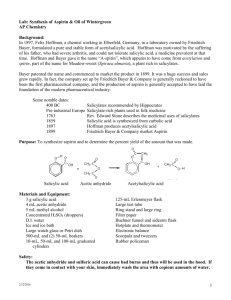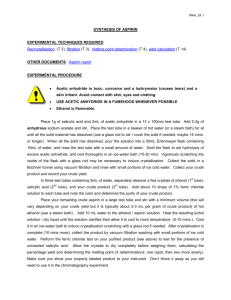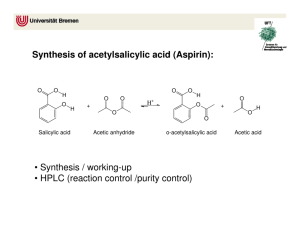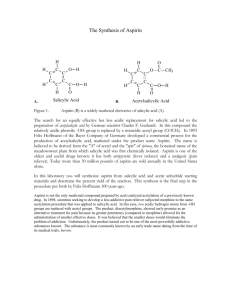to this lab (x)
advertisement
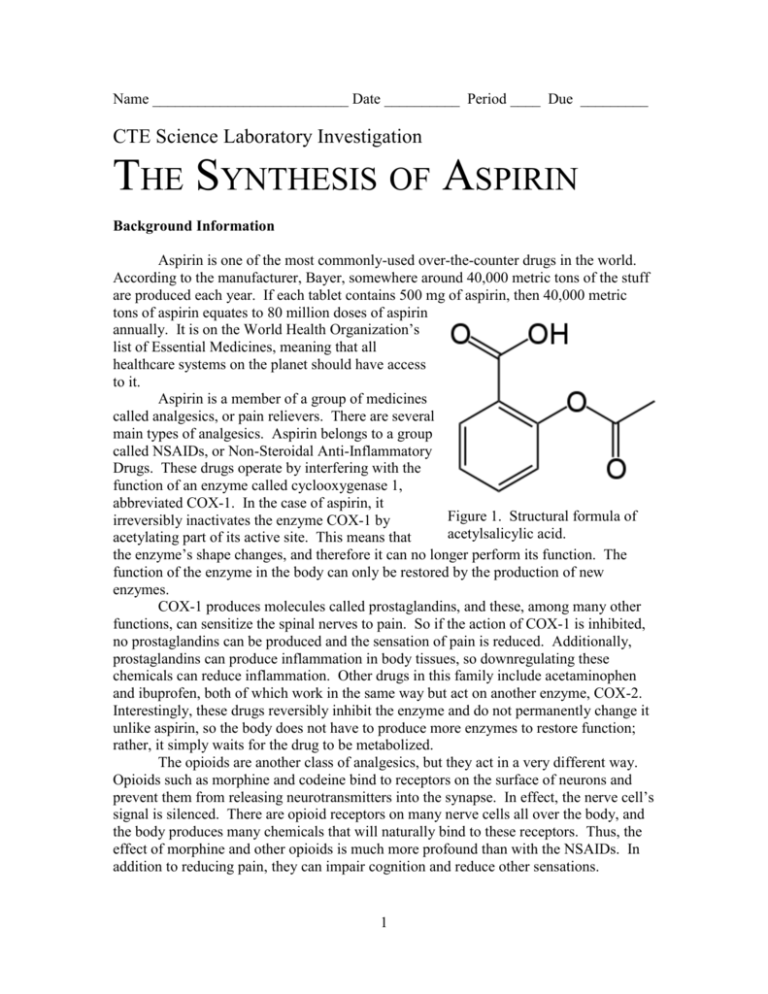
Name __________________________ Date __________ Period ____ Due _________ CTE Science Laboratory Investigation THE SYNTHESIS OF ASPIRIN Background Information Aspirin is one of the most commonly-used over-the-counter drugs in the world. According to the manufacturer, Bayer, somewhere around 40,000 metric tons of the stuff are produced each year. If each tablet contains 500 mg of aspirin, then 40,000 metric tons of aspirin equates to 80 million doses of aspirin annually. It is on the World Health Organization’s list of Essential Medicines, meaning that all healthcare systems on the planet should have access to it. Aspirin is a member of a group of medicines called analgesics, or pain relievers. There are several main types of analgesics. Aspirin belongs to a group called NSAIDs, or Non-Steroidal Anti-Inflammatory Drugs. These drugs operate by interfering with the function of an enzyme called cyclooxygenase 1, abbreviated COX-1. In the case of aspirin, it Figure 1. Structural formula of irreversibly inactivates the enzyme COX-1 by acetylsalicylic acid. acetylating part of its active site. This means that the enzyme’s shape changes, and therefore it can no longer perform its function. The function of the enzyme in the body can only be restored by the production of new enzymes. COX-1 produces molecules called prostaglandins, and these, among many other functions, can sensitize the spinal nerves to pain. So if the action of COX-1 is inhibited, no prostaglandins can be produced and the sensation of pain is reduced. Additionally, prostaglandins can produce inflammation in body tissues, so downregulating these chemicals can reduce inflammation. Other drugs in this family include acetaminophen and ibuprofen, both of which work in the same way but act on another enzyme, COX-2. Interestingly, these drugs reversibly inhibit the enzyme and do not permanently change it unlike aspirin, so the body does not have to produce more enzymes to restore function; rather, it simply waits for the drug to be metabolized. The opioids are another class of analgesics, but they act in a very different way. Opioids such as morphine and codeine bind to receptors on the surface of neurons and prevent them from releasing neurotransmitters into the synapse. In effect, the nerve cell’s signal is silenced. There are opioid receptors on many nerve cells all over the body, and the body produces many chemicals that will naturally bind to these receptors. Thus, the effect of morphine and other opioids is much more profound than with the NSAIDs. In addition to reducing pain, they can impair cognition and reduce other sensations. 1 Aspirin, or acetylsalicylic acid, is fairly safe in recommended dosages, and has been used for thousands of years. The bark of many willow trees produces salicylic acid, and early humans would often chew on the bark or brew it into a tea to reduce fever and pain. Salicylic acid on its own can often irritate the gastrointestinal tract and have other side effects, but scientists at the Bayer company synthesized acetylsalicylic acid, which has many fewer side effects, in 1897, and that form has remained unchanged for over 100 years. We can synthesize aspirin and test its purity very simply, although the drug that we’re going to make is not certified, and so therefore cannot actually be used in humans. Purpose The purpose of this investigation is to synthesize a very common analgesic drug, aspirin, as well as to practice careful measurement and good laboratory techniques. Procedure N.B. – You will be using several chemicals that are extremely corrosive to body tissues. Both the sulfuric acid and acetic anhydride will cause severe burns if they come in contact with your skin. You MUST have your safety goggles on at all times. MAKE SURE that you record the EXACT mass or volume of each reagent that you add, even if it differs from what the procedure tells you to add, so that you can calculate your percent yield at the end of the experiment. If the procedure calls for 7 g and you add 7.06 g, you MUST record 7.06 g! PART I – SYNTHESIZE ASPIRIN 1. Set up a water bath at your lab bench. Use a 600 mL beaker for the bath, and a hotplate to heat it. The water should be gently boiling. 2. Measure out 2.00 g of salicylic acid into a clean, dry, 125 mL Erlenmeyer flask. 3. In the hood, using a glass pipette, add 4 mL of acetic anhydride to the flask. 4. In the hood, add 5 drops of concentrated sulfuric acid. Carefully swirl the flask to mix completely. All of the solid will not dissolve. 5. Heat in the water bath for 15 minutes. All the solids should be completely dissolved. 6. In order to decompose any extra acetic anhydride into acetic acid, add about 10 mL of ICE COLD distilled water slowly, dropwise to the flask. This may cause vapors and splattering, and you may note a strong smell of vinegar. Keep the flask tilted away from you. 7. Let the flask cool for about five minutes, and then transfer it to an ice bath, swirling occasionally. Crystals should start to form. If they do not, scratch the side of the flask with a glass stirring rod, or shake it gently. 8. Add 5 mL of ICE COLD distilled water. 9. Find the mass of a piece of filter paper, and place it on a Büchner funnel. 10. Wet the paper with a few mL of ice cold distilled water. 2 11. Turn on the suction and add all of your solution to the funnel. Use a wash bottle of ice cold distilled water to rinse out any excess precipitate. 12. Pull air through the product to speed its drying, then dry it overnight in an area specified by your teacher. PART II – TEST YOUR PRODUCT 1. Obtain four clean test tubes. Add about 1 mL of distilled water to each tube. 2. To tube one, add a small crystal of your dried aspirin product and label this “experimental.” 3. To tube two, add a small amount of powdered commercial aspirin, and label this “commercial.” 4. To tube three, add a small amount of salicylic acid and label it “acid.” 5. To tube four, add about 1 mL of distilled water. This tube will act as your control. Label it “control.” 6. To each tube, add 1 mL of Iron Chloride. Iron chloride will react with a part of the salicylic acid molecule called the phenol group, to form a dark purple solution. When aspirin is synthesized, this phenol group is removed and replaced with an acetyl group, which does not trigger a purple color change. Mass of Salicylic Acid (g) Volume of Acetic Anhydride (mL) Mass of Acetic Anhydride (g) Mass of Filter Paper and Aspirin (g) Mass of Aspirin (g) Table 1. Mass data for reactants. Mass of Dry Filter Paper (g) Table 2. Mass data for products. Analysis QUESTION 1: Balance, if needed, the equation for the production of acetylsalicylic acid from acetic anhydride and salicylic acid, by placing coefficients in front of each compound. __ C7H6O3 + __ C4H6O3 __ C9H8O4 + __ C2H4O2 QUESTION 2: Based on the balanced equation, how many moles of each reactant are needed to make 1 mole of the final product? 3 QUESTION 3: Determine the molar mass of salicylic acid, acetic anhydride and acetylsalicylic acid. QUESTION 4: Based on your data, determine how many moles of each reactant you used and how many moles of acetylsalicylic acid you produced. QUESTION 5: Based on your data from question 4, was your reaction perfectly efficient? If not, how far off were you? Put another way, what is the percent error for your reaction? Use the percent error formula. Use the actual amount of aspirin that you produced as the experimental value and the amount that you predicted from the balanced equation as the accepted value. QUESTION 6. What could have accounted for the difference in these values? QUESTION 7: What are two things that you would change about this lab if you could. 4

